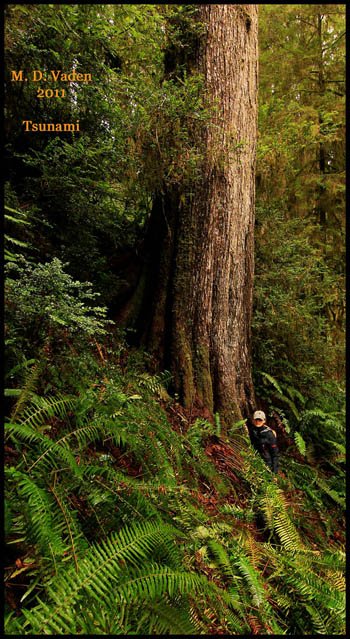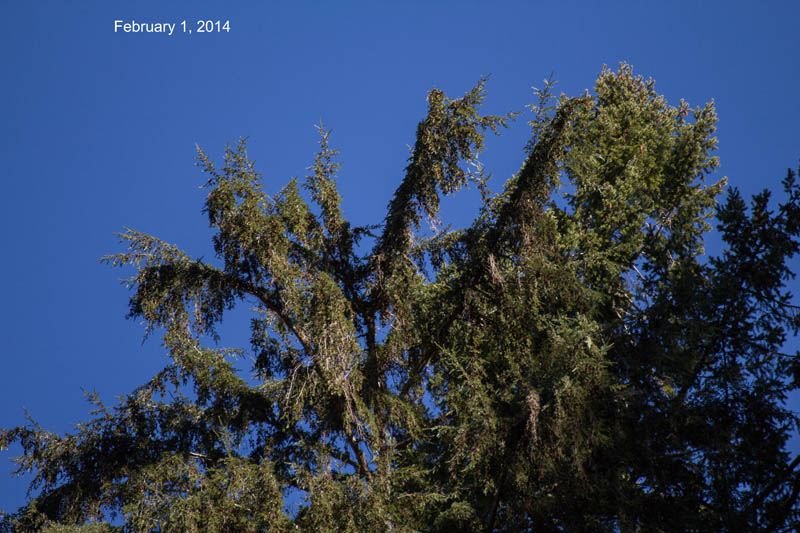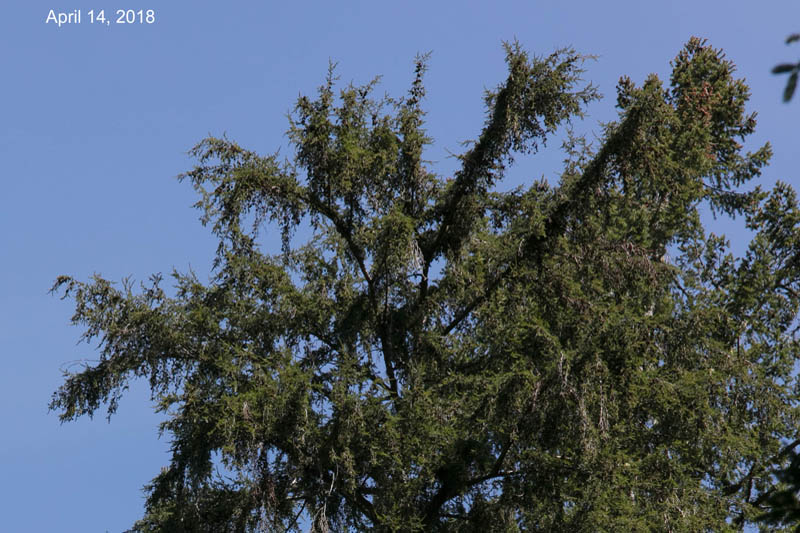
World's Tallest Hemlock Discovery 2011 .. Tsunami
271.75 ft. | 82.83 m. tall. Tsuga heterophylla .. Oct. 2014 remeasure 273.42 ft.
2018 update: Tsunami was found March 2011. October 2011, Chris Atkins found another western hemlock over 270 ft.,. The 273.42 ft. measurement of Tsunami was done 2014 with Atkins. April 2018, I returned to Prairie Creek to photograph the top of Tsunami and record condition. After 7 years and a couple drought-like growing seasons, the top is intact with new growth. So I'm able to confirm that both Tsunami and Grogan's Fault (redwood) stand firm. Two photos are added at the bottom of the page from 2014 and 2018. In a larger file, I can identify where new growth occured.
2019 update: we didn't measure in 2019, but photos show some extra elongation of a couple tops
Circumference 238" / 6.16 ft. diameter dbh / 1/4 crown estimate 11 points / 522 AF points. This hemlock is basically a triple national co-champion with 523 point and 527 point western hemlocks in the Olympic National Park. But I did not nominate it. When an Oregon pine was nominated, the tallest pine we found was measured too, and the verification climbing team let too many people know the location. Discovery included at conifers.org.

Prairie Creek .. March 12, 2011
This hemlock find was on right on the heels of the World's Tallest Pine Discovery 2011. The weekend began March 11, 2011 in Prairie Creek redwoods state park at 4:30am experimenting with a lantern for photography in the dark.
At 6am, I drove to Klamath for breakfast where I learned about the Tsunami alert for the redwood coast. The Cafe served meals until 7am and closed shop. 10 minutes later, police let me through the roadblock on Highway 101 because I was headed into the redwoods which is higher ground.
My exploring began with Brown Creek trail and included other trails like James Irvine, Rhododendron and part of Westridge.
March 12th along Drury Parkway, researchers Steve Sillett & Marie Antoinne of Humboldt State University happened to drive by on their way to work in the park. We exchanged greetings and went our ways.
About 11:50am, I spotted a very tall western hemlock. The laser read 190 feet to the top above my position. The surprise was a reading of 72 feet more down to where the trunk vanished beneath huckleberry. Combined, that 262 feet alone was a new record.

After an hour of measuring, I came up with an estimate 272 feet.
I returned and found Sillett and Antoinne minutes before they left. They just happened to be exiting the redwood forest with backpacks.
After describing the find, they agreed to check it out and confirm the species, although Sillett wondered if it was really a Sitka spruce when I mentioned the 272 ft. estimate. We reached the location and identification was soon confirmed as western hemlock, Tsuga heterophylla.
The next day March 13th, Michael Taylor arrived and we measured again. The consensus after comparing the Sillett and Taylor measurements was 82.83 meters for total height. It is the first hemlock ever measured over 80 meters tall.
Sillett and I chose the name "Tsunami" accordingly.
The hemlock image to the left is about 11 frames stitched together, but the actual trunk is really almost straight as an arrow.
Although 82.83 meters was the 2011 concensus, that was conservative. Taylor's measurement included the full extent of the trunk on the downhill side for 83.43 meters | 273.73 feet. That with the use of a tripod.
The ground and plants around Tsunami are much more delicate than many other redwoods, Douglas fir and spruce we have measured. So I have no interest to remeasure this trunk on a yearly basis. Maybe three to five year intervals.
But at least I can get a good idea about it's growth and condition. I have photographs from several years. Apparently the top leaders slightly reposition each year due wind, rain weight and new growth. But the top has continued to retain the same overall shape and branches.
The tops of redwoods and Douglas fir are more spikey or rigid. Ends of hemlock are more flexible and delicate. Photos below are from two years. 2014 and 2018. The right center leader is one of the easier ones to spot some new growth on, where it's blunt in the first image, but has new tips in the 2nd image. The heavy cluster of foliage to the right is another species behind it.

advertisement

